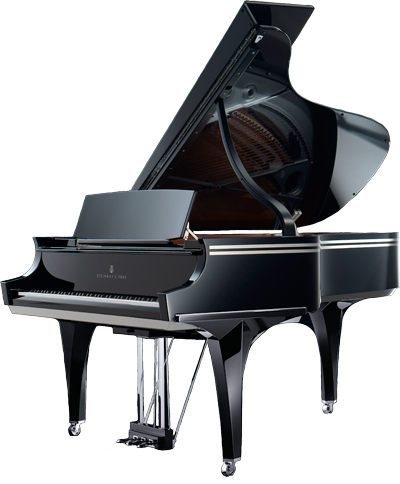Miami Symphony closes season with piano extravaganza
Six pianos, six pianists, 12 hands, 528 keys.
One by one the pianos were wheeled on to the stage of the Arsht Center’s Knight Concert Hall Sunday evening. First, a single Steinway grand for the initial work on the program, then two, then three, and finally six were crammed together for a grandiose finale to the Miami Symphony Orchestra’s season.
For the last performance of a season celebrating the Steinway & Sons piano manufacturing company, the orchestra under music director Eduardo Marturet performed four works for piano—or pianos—and orchestra, ending with Franz Liszt’s gigantic, six-piano Hexameron.
For the first work, however, a single piano sufficed. You could attend concerts for twenty years without running into the Piano Concerto of Aram Khachaturian. One of the Soviet Union’s leading composers, Khachaturian, who was Armenian, produced a concerto that–for all its dissonance–sounds like an attempt to follow in the line of the big Russian piano concertos of Tchaikovsky and Rachmaninoff. The piano is at center stage throughout, the work has several cadenzas and it’s full of virtuosity and drama.
The Israel-born pianist Elisha Abas clearly had the technique for the rapid-fire octaves and intricate finger-work demanded by the concerto. But more than that, he had a feel for the exotic touches of Asian influence in a European form, taking his time to draw out the tensions in the work’s sinewy melodic lines.
Next came the world premiere of the Concerto for Two Pianos and Orchestra by the young Brazilian composer André Mehmari, with the composer at one piano and the American pianist Christopher O’Riley at the other. Any composer who writes a jazz-inspired slow movement and puts a fugue in the last movement is a composer with a wide range of inspirations. For much of the boisterous first movement, you would barely know this was a piano concerto, so discretely did the composer work the piano parts into the orchestra.
But the heart of the work seemed to be the Adagio. Over slow-moving chord progressions in muted strings, the two pianists played jazz-inflected melodies and increasingly intricate riffs, building intensity almost imperceptibly, for a smoky and atmospheric few minutes of music. The last movement broke the tension with a burst of nervous energy and an abrupt ending.
The stage began getting crowded after intermission, with three pianos facing the orchestra for Mozart’s Piano Concerto No. 7 for Three Pianos and Orchestra. At the keyboards were soloists Roberto Berrocal, Ciro Fodere and Marina Radiushina. Compared to the loud huffing and puffing of the Khachaturian and of the Liszt that was to follow, Mozart’s concerto provided a welcome respite, seeming even more tuneful and graceful than usual.
Despite the large forces on stage, there was nothing particularly busy or complex about the concerto. All three pianists played with fluent, long-lined phrasing, as Mozart tossed melodies from piano to piano. The Adagio came off with a soft-toned glow, and the final movement was as buoyant and light as any of Mozart’s works despite the three pianists on stage.
All six pianists came together for the Liszt work, which proved as much a visual spectacle as a musical one; despite the Arsht Center’s policy against photography, smart phones came out as members of the audience tried to record the image of the six pianos lined up in front of the orchestra. Based on a theme from Bellini’s opera I Puritani, the Hexameron was composed by Liszt in collaboration with several colleagues, producing a series of virtuoso variations that led up to a big finale.
This was a classic 19th-century set of operatic variations, a form that tended to produce more opportunities for virtuoso display than it did great music. Despite the enormous keyboard power on stage, the work wasn’t as thunderous throughout as you might expect. For much of the work, Liszt allowed just one pianist to play, letting each one perform a variation–all played with the required speed and agility—as the others took a break.
There were segments when all played, and thanks to the composer’s skill, the pianists’ technique and Marturet’s conducting, these came off as neither muddy nor chaotic. Instead, these were big, complex, rumbling passages—unforgettable aural experiences that are unlikely to be repeated anytime soon. The massive finale, with all pianists pounding away along with the orchestra, was a sonic blast that brought the crowd to its feet and provided a memorable ending to the Miami Symphony’s season.
Posted in Performances
One Response to “Miami Symphony closes season with piano extravaganza”
Leave a Comment
Mon May 4, 2015
at 10:45 am
1 Comment

Posted May 11, 2015 at 9:31 pm by Frank Cooper
Liszt published only the piano solo version of Hexameron. He performed it as his parade piece multiple times, and on several occasions as a solo work with orchestra (the orchestral version has not survived). It was never performed by six pianists during his lifetime, although that had been the idea behind the Princess Beljoioso’s planned benefit concert.
Pianist Raymond Lewenthal has prepared a version for piano and orchestra for my Romantic Music Festival in Indianapolis but withdrew before the performance. My student Stephen Glover, with only three days to prepare, played the piece from memory with the orchestra and was rapturously received. Lewenthal’s score and parts disappeared after his death in 1988.
In any case, the South Florida public should know that the Miami Symphony’s sic-piano rendition was very much an amusing proposition, an arrangement.